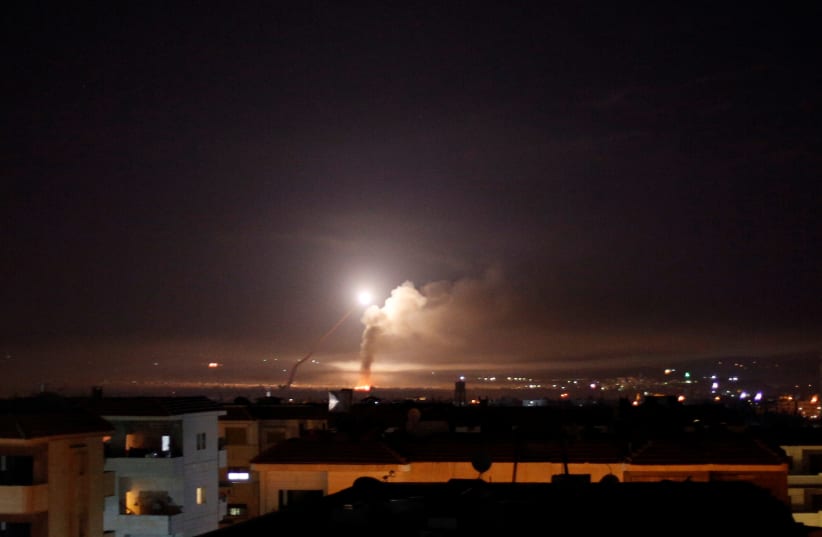The IDF confirmed Friday that fragments of a Syrian anti-aircraft missile were found in an open area in Israel’s Golan Heights several hours after the Syrian regime said it had downed “hostile targets” over the southern part of the country the previous night.
According to local reports, on Thursday evening Israeli missiles targeted sites belonging to Iranian-backed militias in al-Kiswah, south of the capital of Damascus and some 50 km. from the border with Israel.
Syria’s official Sana news agency quoted a military source as saying that “air defense intercepts hostile targets over al-Kiswah and downed them,” and that “the Israeli attack did not achieve its goals.”
Russia’s RIA news agency cited a Syrian security source as saying that the “Syrian air defense forces shot down an Israeli war plane and four missiles.”
#BREAKING: @AlHadath sources: Israeli jets strike positions of Iranian proxy militias in southern Syria pic.twitter.com/Q099cwl50A
— Amichai Stein (@AmichaiStein1) November 29, 2018
The IDF spokesperson’s unit confirmed on Thursday that Israel’s air defense system had identified one Syrian surface-to-air missile projectile that had been launched toward the Golan Heights, but stressed that all reports that an Israeli aircraft being shot down were false.
Israeli officials have repeatedly voiced concerns over the growing Iranian presence on its borders and the smuggling of sophisticated weaponry to Hezbollah from Tehran to Lebanon via Syria, stressing that both are redlines for the Jewish state.
With the presence of Iranian and Hezbollah forces, Israel’s northern front has become the IDF’s top priority. Working to prevent the entrenchment of Iranian forces and the transfer of advanced weaponry to Hezbollah, the Israel Air Force has admitted to carrying out hundreds of air strikes in Syria.
Nevertheless Iran has “changed tactics” in Syria and has been focusing on building its presence in Iraq and Lebanon instead, the former head of Military Intelligence Maj.-Gen. Amos Yadlin said on Israel’s Radio 103FM on Thursday.
“The Iranians decreased their military establishment activity in Syria, due both to their vulnerability and Russia’s demands not to undermine Syria’s stabilization efforts,” he said, adding that “Russia’s strategy is to stabilize Syria, and Iran was disrupting that by developing its precision missile facilities.”
Yet, he said, “it is important to remember that Iran has never forsaken its Middle East hegemonic aspirations, and moved to establish their advanced military infrastructure against Israel in Lebanon and Iraq.”
While Russia has recently provided the S-300 advanced anti-aircraft missile batteries to the Syrian regime, Israel has said that it will continue to operate in the war-torn country as long as Iran remains.
According to a new report published by the Washington-based Institute for the Study of War, Russia has completed a comprehensive air defense system in Syria that constrains the United States’ ability to operate in the country and in the eastern Mediterranean. The report paints a stark picture of increasing Russian entrenchment in Syria as Putin and the West have squared off in recent days over naval confrontations in Crimea with Ukraine.
Underlying the Kremlin’s efforts, the report claims, is a wider push to force American troops to withdraw from Syria.
Russia delivered the S-300 anti-aircraft launcher, radar and command and control vehicle of the advanced air-to-surface missile system to Syria in early October as a response to the downing of a Russian reconnaissance plane by Syrian air defenses during an Israeli air strike on Iranian targets the previous month.
The system was deployed to Masyaf in northwestern Syria and is not believed to be operational yet.
Moscow said it would also impose electronic countermeasures over Syria’s coastline to suppress satellite navigation, onboard radar systems and communications of warplanes attacking targets on Syrian territory.
If Israel did conduct the strike on Thursday, it would mark one of the few alleged IAF strikes since the downing of the Russian plane which led to tensions between Moscow and Jerusalem.
In May, Israeli air strikes targeted Iranian targets belonging to Iranian Revolutionary Guard Corps’s Quds Force and included intelligence sites, a military compound and logistics complex in Kiswah, weapons storage sites at Damascus International Airport, and intelligence systems and installations, as well as observation, military posts and military hardware in the buffer zone.
According to the Britain-based Syrian Observatory for Human Rights, at least 11 Iranians were among the 46 killed in Israel’s strikes launched in retaliation after 20 rockets were fired toward Israel’s front defensive line in the Golan Heights by the Quds Force.
In a report published on The American Interest news site, one of the targets struck included the “Glasshouse” facility at the Damascus International Airport used by the IRGC as its headquarters under the command of Gen. Hussein Kaani to supervise operations closer to the border with Israel.
